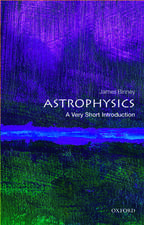Supernovae: Astronomy and Astrophysics Library
Editat de Albert G. Petscheken Limba Engleză Paperback – 26 sep 2011
Din seria Astronomy and Astrophysics Library
- 17%
 Preț: 496.37 lei
Preț: 496.37 lei - 15%
 Preț: 603.58 lei
Preț: 603.58 lei - 19%
 Preț: 455.24 lei
Preț: 455.24 lei - 17%
 Preț: 525.72 lei
Preț: 525.72 lei - 13%
 Preț: 393.37 lei
Preț: 393.37 lei - 19%
 Preț: 524.14 lei
Preț: 524.14 lei - 17%
 Preț: 393.90 lei
Preț: 393.90 lei - 15%
 Preț: 647.40 lei
Preț: 647.40 lei - 15%
 Preț: 541.54 lei
Preț: 541.54 lei - 17%
 Preț: 362.70 lei
Preț: 362.70 lei - 18%
 Preț: 1006.55 lei
Preț: 1006.55 lei - 18%
 Preț: 745.33 lei
Preț: 745.33 lei - 15%
 Preț: 641.20 lei
Preț: 641.20 lei -
 Preț: 397.38 lei
Preț: 397.38 lei - 15%
 Preț: 598.21 lei
Preț: 598.21 lei - 15%
 Preț: 658.05 lei
Preț: 658.05 lei - 23%
 Preț: 815.07 lei
Preț: 815.07 lei -
 Preț: 409.89 lei
Preț: 409.89 lei - 15%
 Preț: 610.61 lei
Preț: 610.61 lei -
 Preț: 393.90 lei
Preț: 393.90 lei - 15%
 Preț: 655.27 lei
Preț: 655.27 lei - 18%
 Preț: 951.47 lei
Preț: 951.47 lei - 18%
 Preț: 960.42 lei
Preț: 960.42 lei - 18%
 Preț: 1397.68 lei
Preț: 1397.68 lei - 18%
 Preț: 959.98 lei
Preț: 959.98 lei - 18%
 Preț: 1012.08 lei
Preț: 1012.08 lei - 15%
 Preț: 481.03 lei
Preț: 481.03 lei - 15%
 Preț: 672.43 lei
Preț: 672.43 lei -
 Preț: 413.15 lei
Preț: 413.15 lei - 18%
 Preț: 1554.72 lei
Preț: 1554.72 lei - 18%
 Preț: 1410.63 lei
Preț: 1410.63 lei -
 Preț: 390.08 lei
Preț: 390.08 lei - 18%
 Preț: 944.99 lei
Preț: 944.99 lei - 19%
 Preț: 502.94 lei
Preț: 502.94 lei - 15%
 Preț: 654.12 lei
Preț: 654.12 lei - 24%
 Preț: 851.62 lei
Preț: 851.62 lei - 19%
 Preț: 515.32 lei
Preț: 515.32 lei - 15%
 Preț: 663.14 lei
Preț: 663.14 lei - 15%
 Preț: 656.43 lei
Preț: 656.43 lei - 18%
 Preț: 741.68 lei
Preț: 741.68 lei - 15%
 Preț: 647.40 lei
Preț: 647.40 lei -
 Preț: 388.90 lei
Preț: 388.90 lei - 18%
 Preț: 1217.72 lei
Preț: 1217.72 lei - 15%
 Preț: 651.51 lei
Preț: 651.51 lei - 15%
 Preț: 655.27 lei
Preț: 655.27 lei -
 Preț: 347.59 lei
Preț: 347.59 lei - 18%
 Preț: 794.39 lei
Preț: 794.39 lei
Preț: 389.11 lei
Nou
Puncte Express: 584
Preț estimativ în valută:
74.45€ • 77.96$ • 61.76£
74.45€ • 77.96$ • 61.76£
Carte tipărită la comandă
Livrare economică 09-23 aprilie
Preluare comenzi: 021 569.72.76
Specificații
ISBN-13: 9781461279518
ISBN-10: 1461279518
Pagini: 312
Ilustrații: XIII, 293 p.
Dimensiuni: 155 x 235 x 16 mm
Greutate: 0.44 kg
Ediția:Softcover reprint of the original 1st ed. 1990
Editura: Springer
Colecția Springer
Seria Astronomy and Astrophysics Library
Locul publicării:New York, NY, United States
ISBN-10: 1461279518
Pagini: 312
Ilustrații: XIII, 293 p.
Dimensiuni: 155 x 235 x 16 mm
Greutate: 0.44 kg
Ediția:Softcover reprint of the original 1st ed. 1990
Editura: Springer
Colecția Springer
Seria Astronomy and Astrophysics Library
Locul publicării:New York, NY, United States
Public țintă
ResearchCuprins
1 Classification of Supernovae.- 1.1. Introduction.- 1.2. Observed Time Dependence.- 1.3. Theory.- 1.4. SN 1987K.- 1.5. Conclusions.- References.- 2 Spectra of Supernovae.- 2.1. Introduction.- 2.2. Historical Overview.- 2.3. Individual Supernovae: Spectral Types and Bibliography.- 2.4. Spectrum Formation.- 2.5. Spectral Types Ia, Ib, and II.- 2.6. Toward Quantitative Spectroscopy.- References.- 3 Supernova Light Curves.- 3.1. Introduction.- 3.2. Light Curves of Type IA Supernovae.- 3.3. The Light Curves of SN Ib.- 3.4. The Cosmological Uses of SN Ia.- 3.5. Light Curves for SN II.- 3.6. Cosmology and SN II.- References.- 4 Radio Supernovae.- 4.1. Introduction.- 4.2. Radio Emission from SN 1970G.- 4.3. Further Radio Detections of Type II Supernovae.- 4.4. Radio Detection of Type I Supernovae.- 4.5. Supernovae Discovered by Their Radio Emission.- 4.6. Intermediate Age Radio Supernovae.- 4.7. Very Early Radio Emission from SN 1987A.- 4.8. Summary of Radio Supernovae.- 4.9. Models for the Supernova Radio Emission.- 4.10. Conclusion.- References.- 5 Interaction of Supernovae with Circumstellar Matter.- 5.1. Introduction.- 5.2. Circumstellar Environments.- 5.3. Hydrodynamic Interaction.- 5.4. Radiative Interaction.- 5.5. Summary and Future Prospects.- References.- 6 Gamma-Rays and X-Rays from Supernovae.- 6.1. Introduction.- 6.2. Prompt Emission, Radiation from Interaction with a Wind, and Very High-Energy Radiation.- 6.3. Gamma-Rays and X-Rays due to Radioactive Decay.- 6.4. SN 1987A.- 6.5. Concluding Remarks.- References.- 7 Neutrinos from Supernovae.- 7.1. Introduction.- 7.2. A Short History of Supernova Neutrino Theory.- 7.3. The Neutrino Signature of Core Collapse Supernovae.- 7.4. The Neutrinos from SN 1987A.- Appendix: Detectors.- References.- 8 Type I Supernovae: Carbon Deflagration and Detonation.- 8.1. Introduction.- 8.2. The Pre-Explosive Evolution.- 8.3. Some General Considerations.- 8.4. Carbon Deflagration.- 8.5. Carbon Detonation.- 8.6. Type Ib Supernovae.- 8.7. Type I21 Supernovae.- 8.8. Conclusions.- References.- 9 Supernovae: The Direct Mechanism and the Equation of State.- 9.1. Introduction.- 9.2. Gravitational Collapse.- 9.3. Subsaturation Density Equation of State.- 9.4. Suprasaturation Density Equation of State.- 9.5. Numerical Results.- 9.6. Rotation.- 9.7. Discussion.- References.- 10 Neutrino Heating Supernovae.- 10.1. Introduction.- 10.2. Brief Review of Numerical Work.- 10.3. Collapse-Driven Supernova.- 10.4. Calculational Neutrino Spectra and Luminosity from Collapsed Stellar Cores.- 10.5. The Neutrino Heating Mechanism for Supernova Explosions: A Critique.- References.










